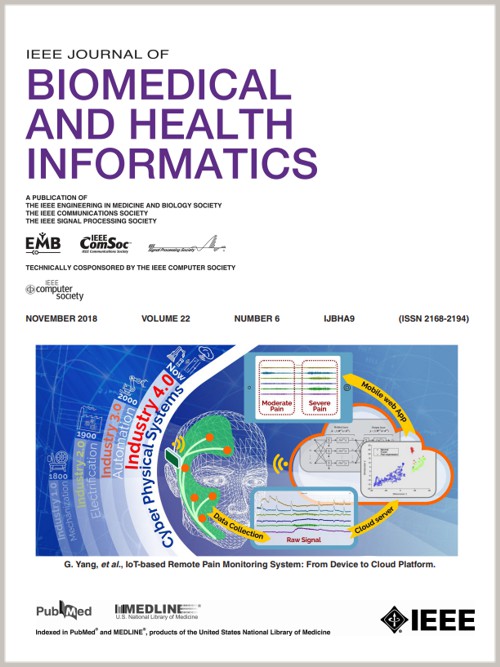基于结构磁共振图像 ROI 特征的失语症评估新方法
IF 6.7
2区 医学
Q1 COMPUTER SCIENCE, INFORMATION SYSTEMS
IEEE Journal of Biomedical and Health Informatics
Pub Date : 2024-11-04
DOI:10.1109/JBHI.2024.3492072
引用次数: 0
摘要
失语症影响着三分之一的中风幸存者,损害语言理解能力和言语表达能力,导致日常交流困难、社会孤立和经济损失。评估失语症对患者的有效康复和恢复至关重要。然而,传统的基于行为的评估依赖于语言病理学家,容易受到个体差异的影响,导致人力成本高、过程耗时长、稳健性低。为了解决这些局限性,本研究引入了一种基于医学图像处理和人工智能的新型评估方法。磁共振成像(MRI)可提供卓越的空间分辨率,同时减轻个体差异的影响。利用图像处理技术提取病理特征,特别是基于感兴趣区(ROI)的特征。随后,利用基于 ROI 的特征对评估模型进行了训练,这些特征可初步识别失语症的发生,然后对失语症的类型进行分类,从而帮助临床医生根据不同的治疗方法和强度进行治疗。评估模型还能预测严重程度,并生成四种语言功能的评分:自发言语、听觉理解、命名和复述。失语症发生检测和失语症类型分类的准确率分别为 100.00 ± 0.00% 和 85.00 ± 13.23%,令人印象深刻。严重程度预测的均方根误差(RMSE)最小,为 17.03 ± 2.75,而四种语言功能评估的均方根误差(RMSE)最佳,为 1.27 ± 0.82。利用基于医学影像的自动化方法的优势,所提出的失语症评估方法提供了一个全面的程序,并产生了相当准确的结果。因此,它可以帮助失语症患者康复,并大大减轻临床医生的工作量。本文章由计算机程序翻译,如有差异,请以英文原文为准。
A Novel Approach for Aphasia Evaluation Based on ROI-Based Features From Structural Magnetic Resonance Image
Aphasia, affecting one-third of stroke survivors, impairs language comprehension and speech production, leading to challenges in daily interactions, social isolation, and economic losses. Assessing aphasia is crucial for effective rehabilitation and recovery in patients. However, the conventional behavioral-based evaluation, reliant on speech pathologists, is susceptible to individual variability, resulting in high labor costs, time-consuming processes, and low robustness. To address these limitations, this study introduces a novel evaluation method based on medical image processing and artificial intelligence. Magnetic resonance imaging (MRI) provides exceptional spatial resolution while mitigating the impact of individual variability. The image processing techniques were employed to extract pathological features, specifically region-of-interest (ROI)-based features. Subsequently, the evaluation models were trained using ROI-based features which initially identify the occurrence of aphasia and then categorize the type of aphasia, aiding clinicians in tailoring treatment to various therapeutic approaches and intensities. The evaluation models also predict the severity and generate scores for four types of language function: spontaneous speech, auditory comprehension, naming, and repetition. Both aphasia occurrence detection and aphasia type classification attain impressive accuracy rates of 100.00 $\pm$ $\pm$ $\pm$ $\pm$
求助全文
通过发布文献求助,成功后即可免费获取论文全文。
去求助
来源期刊

IEEE Journal of Biomedical and Health Informatics
COMPUTER SCIENCE, INFORMATION SYSTEMS-COMPUTER SCIENCE, INTERDISCIPLINARY APPLICATIONS
CiteScore
13.60
自引率
6.50%
发文量
1151
期刊介绍:
IEEE Journal of Biomedical and Health Informatics publishes original papers presenting recent advances where information and communication technologies intersect with health, healthcare, life sciences, and biomedicine. Topics include acquisition, transmission, storage, retrieval, management, and analysis of biomedical and health information. The journal covers applications of information technologies in healthcare, patient monitoring, preventive care, early disease diagnosis, therapy discovery, and personalized treatment protocols. It explores electronic medical and health records, clinical information systems, decision support systems, medical and biological imaging informatics, wearable systems, body area/sensor networks, and more. Integration-related topics like interoperability, evidence-based medicine, and secure patient data are also addressed.
 求助内容:
求助内容: 应助结果提醒方式:
应助结果提醒方式:


